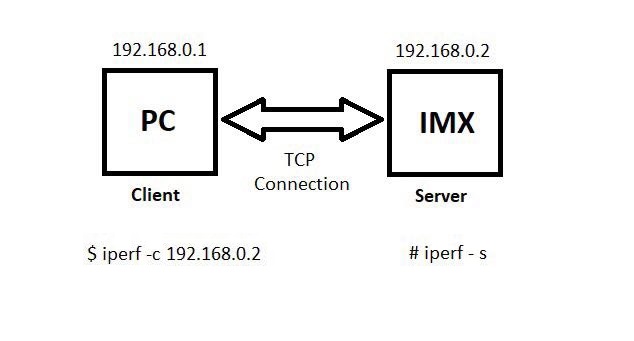How to measure network speed and bandwidth on iMX boards
Introduction
This post is designated for those who want to test the network performance in terms of speed and bandwidth on iMX boards. The iperf tool is used for executing this test, it is very reliable and also an open source tool released under a three-clause BSD license.
The iperf works by the client side sending data to the server side, making it possible to measure the network throughput between them. The throughput is the transfer rate of data from one place to another in a period of time, it is also measured in Kbps, Mbps, and Gbps.
The diagram shows the communication between the machines and how it works:

For more information: https://iperf.fr/
Iperf on Host Machine
For installing the iperf tool on your host machine, use the apt-get repository:
$ sudo apt-get install iperf
Iperf tool binaries
This section describes how to add the iperf package to fsl-community-bsp. For this example it was used a iMX6QSabre SD Board:
Yocto Project
To install the FSL Community BSP, follow the steps describes here.
For including iperf tool, add the following line inside local.conf:
CORE_IMAGE_EXTRA_INSTALL += " iperf3 "
Then, run the bitbake command:
$ bitbake core-image-base
Your image is prepared for running iperf tool.
Iperf test
Follow an example showing iperf where iMX board is a server, and the computer is a client for sending data to the server. With this test it will be possible to measure the iMX network performance:
For running iMX as a server:
# iperf -s
------------------------------------------------------------
Server listening on TCP port 5001
TCP window size: 85.3 KByte (default)
------------------------------------------------------------
- -s argument is used for specifying server
The above command, starts iperf server on the iMX board, and it by default runs on the port 5001, it also reports that the default TCP Windows Size is 85.3KByte (These configurations can be changed using the corresponding parameters).
If your board does not get an ip, run the follow command: udhcp
For running the computer as a client:
$ iperf -c <imx_board_ip>
- -c argument is used for specifying client
Iperf results
Running the above command, the connection will start transfer the data and show the results:
$ iperf -c 10.29.244.45
------------------------------------------------------------
Client connecting to 10.29.244.45, TCP port 5001
TCP window size: 85.0 KByte (default)
------------------------------------------------------------
[ 3] local 10.29.240.152 port 60642 connected with 10.29.244.45 port 5001
[ ID] Interval Transfer Bandwidth
[ 3] 0.0-10.0 sec 522 MBytes 438 Mbits/sec
From the above output, you can see that the iMX board got a speed of 438Mbits/sec.
The output shows something more:
-
Interval: Interval specifies the time duration for which the data is transferred.
-
Transfer: All data transferred using iperf is through memory, and is flushed out after completing the test. So there is no need to clear the transferred file after the test. This column shows the transferred data size.
-
Bandwidth: This shows the rate of speed with which the data is transferred.
On the iMX server side, you also have the results:
# iperf -s
------------------------------------------------------------
Server listening on TCP port 5001
TCP window size: 85.3 KByte (default)
------------------------------------------------------------
[ 4] local 10.29.244.45 port 5001 connected with 10.29.240.152 port 60642
[ ID] Interval Transfer Bandwidth
[ 4] 0.0-10.0 sec 522 MBytes 437 Mbits/sec
These results show the network throughput of the iMX6Sabre SD board. It is also possible to change the sides, by making the computer be a server and the iMX board a client.